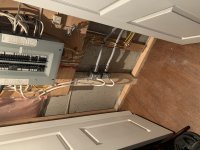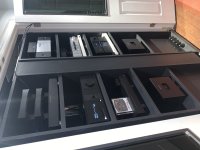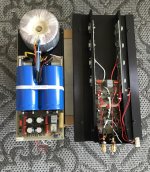ADCO
New member
- Thread Author
- #1
Good Boxing Day all
First off this is not about a mega dollar power cord, in fact just the opposite
I currently run a set of custum built Clayton Audio mono amps that are rated at 200 watts per amp into 8 ohms in class A.
These are a significant load and the pair of them were plugged into a dedicated 20 Amp circuit wired with #10 cable through the walls (approx 50 ft)
The thought of adding another dedicated line so I had one for each amp was always there as the theoretical limits of the one 20 Amp line was getting taxed ( based on typical calculations of Class A efficiency )
What I did instead is have a small niche company here in Canada Custum make some 50’ power cords.
I would run # 8/2 wire from the service panel to about 1 metre from the panel itself where each of these #8/2 cables were terminated into there own box using a single head Furutech GTX-S NFC receptacle. The new power cords would plug into these and run in the open part of my basement adjacent to my listening room and come through the closet wall and plug directly into the amps
These power cords are built with two #7.5 gauge hot wires, two #7.5 neutral wires and one #7.5 gauge ground wire in a braided geometry with all proper Teflon dielectrics , double shielded ( as per my request ) and terminated in a mid level Furutech ends.
Anyway, I was not prepared for the sonic benefits that came from this. My basic expectation was to gain some minor headroom for the amps due to the original set up of the receptacle having just one 20amp line.
The power supply on the Clayton’s is custom and nothing short of outstanding so I figured the headroom and some price of mind would be the gains.
I have used his power cords for the amps to the single receptacle (2metre length) and too my Furman Ref 20i power conditioner for my digital front end….Both to great surprise in cost to performance ratio.
This rather (relatively) inexpensive “upgrade”has brought about such a significant improvement it really is boggling. Things just relaxed , but got quicker ( no idea how that works) things smoothed out but certainly at zero expense to resolution, spacial cues are far more defined but as a whole landscape not just as individual. It’s remarkable really.
My guess is we have removed a layer of AC noise I had no clue was there. The equipment in play is of a high standard , in fact reference by all but the most well heeled so we were coming from a place where gains tend to get smaller and smaller and cost more to do so.
I have no connection to the company ( NRG Custom Cables) and don’t want to come off as a fanboy. That said this experiment is quite a revelation. Perhaps we could have got there with (for example) JPS Labs in wall cable or the like. But this is an utter success.
In the future I think I will invest in two Shunyata Typhon T2’s where these long power cords plug into, one for each amp and then go to an upgraded power cord from there . But….That’s a hard maybe due to cost
Just thought I would share
First off this is not about a mega dollar power cord, in fact just the opposite
I currently run a set of custum built Clayton Audio mono amps that are rated at 200 watts per amp into 8 ohms in class A.
These are a significant load and the pair of them were plugged into a dedicated 20 Amp circuit wired with #10 cable through the walls (approx 50 ft)
The thought of adding another dedicated line so I had one for each amp was always there as the theoretical limits of the one 20 Amp line was getting taxed ( based on typical calculations of Class A efficiency )
What I did instead is have a small niche company here in Canada Custum make some 50’ power cords.
I would run # 8/2 wire from the service panel to about 1 metre from the panel itself where each of these #8/2 cables were terminated into there own box using a single head Furutech GTX-S NFC receptacle. The new power cords would plug into these and run in the open part of my basement adjacent to my listening room and come through the closet wall and plug directly into the amps
These power cords are built with two #7.5 gauge hot wires, two #7.5 neutral wires and one #7.5 gauge ground wire in a braided geometry with all proper Teflon dielectrics , double shielded ( as per my request ) and terminated in a mid level Furutech ends.
Anyway, I was not prepared for the sonic benefits that came from this. My basic expectation was to gain some minor headroom for the amps due to the original set up of the receptacle having just one 20amp line.
The power supply on the Clayton’s is custom and nothing short of outstanding so I figured the headroom and some price of mind would be the gains.
I have used his power cords for the amps to the single receptacle (2metre length) and too my Furman Ref 20i power conditioner for my digital front end….Both to great surprise in cost to performance ratio.
This rather (relatively) inexpensive “upgrade”has brought about such a significant improvement it really is boggling. Things just relaxed , but got quicker ( no idea how that works) things smoothed out but certainly at zero expense to resolution, spacial cues are far more defined but as a whole landscape not just as individual. It’s remarkable really.
My guess is we have removed a layer of AC noise I had no clue was there. The equipment in play is of a high standard , in fact reference by all but the most well heeled so we were coming from a place where gains tend to get smaller and smaller and cost more to do so.
I have no connection to the company ( NRG Custom Cables) and don’t want to come off as a fanboy. That said this experiment is quite a revelation. Perhaps we could have got there with (for example) JPS Labs in wall cable or the like. But this is an utter success.
In the future I think I will invest in two Shunyata Typhon T2’s where these long power cords plug into, one for each amp and then go to an upgraded power cord from there . But….That’s a hard maybe due to cost
Just thought I would share
Last edited:






